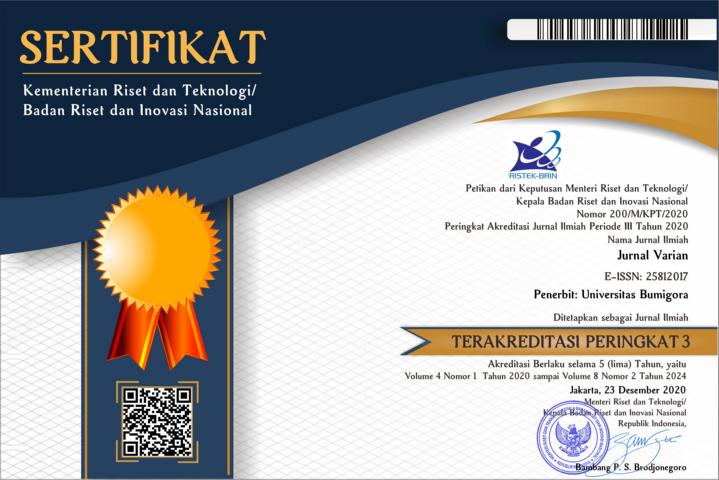Spatial Econometric Model on Economic Growth in West Nusa Tenggara
Abstract
Gross Regional Domestic Product (GRDP) is a reflection of a region's economic growth. West Nusa Tenggara (NTB) is one of the provinces that contributes to good GRDP for Indonesia. The purpose of this research is to modeling GRDP in NTB using spatial econmetrics. The data used is the GRDP data of each district / city in NTB Province as a response variable and factors that affect the number of workers, capital value and electrification ratio as predictor variables. The results showed that there is a spatial dependence on the district / city GRDP in NTB Province on the error model so that the model formed is the Spatial Error Model (SEM) with a rho of 71.1% and an AIC value of 173.34.
References
Feng, Yanchao, Xiaohong Wang, Wenchao Du, Hongyu Wu, and Jintao Wang. 2019. “Effects of Environmental Regulation and FDI on Urban Innovation in China: A Spatial Durbin Econometric Analysis.” Journal of Cleaner Production 235:210–24. doi: 10.1016/j.jclepro.2019.06.184.
Kopczewska, K., J. Kudła, and K. Walczyk. 2017. “Strategy of Spatial Panel Estimation: Spatial Spillovers Between Taxation and Economic Growth.” Applied Spatial Analysis and Policy 10(1):77–102. doi: 10.1007/s12061-015-9170-2.
Li, Jinying, and Sisi Li. 2020. “Energy Investment, Economic Growth and Carbon Emissions in China—Empirical Analysis Based on Spatial Durbin Model.” Energy Policy 140(March):111425. doi: 10.1016/j.enpol.2020.111425.
Li, Miaoqi, and Emily L. Kang. 2019. “Randomized Algorithms of Maximum Likelihood Estimation with Spatial Autoregressive Models for Large-Scale Networks.” Statistics and Computing 29(5):1165–79. doi: 10.1007/s11222-019-09862-4.
Postiglione, Paolo, Alfredo Cartone, and Domenica Panzera. 2020. “Economic Convergence in EU NUTS 3 Regions: A Spatial Econometric Perspective.” Sustainability (Switzerland) 12(17). doi: 10.3390/SU12176717.
Rizky, Reza Lainatul, Grisvia Agustin, and Imam Mukhlis. 2016. “Pengaruh Penanaman Modal Asing, Penanaman Modal Dalam Negeri Dan Belanja Modal Terhadap Pertumbuhan Ekonomi Provinsi Di Indonesia.” Jurnal Ekonomi Dan Ekonomi Studi Pembangunan 8(1):9–16. doi: 10.17977/um002v8i12016p009.
Sadhukhan, Jhuma, Elias Martinez-Hernandez, Myriam A. Amezcua-Allieri, Jorge Aburto, and J. Amador Honorato S. 2019. “Economic and Environmental Impact Evaluation of Various Biomass Feedstock for Bioethanol Production and Correlations to Lignocellulosic Composition.” Bioresource Technology Reports 7(May):100230. doi: 10.1016/j.biteb.2019.100230.
Setiawan, Santi Puteri Rahayu, Siti Soraya. 2017. “Economic Growth Modelling In East Java Using Bayesian.” Teknomatika 07(02):57–69.
Seya, Hajime, Morito Tsutsumi, and Yoshiki Yamagata. 2012. “Income Convergence in Japan: A Bayesian Spatial Durbin Model Approach.” Economic Modelling 29(1):60–71. doi: 10.1016/j.econmod.2010.10.022.
Silhavy, Radek, Petr Silhavy, and Zdenka Prokopova. 2017. “Analysis and Selection of a Regression Model for the Use Case Points Method Using a Stepwise Approach.” Journal of Systems and Software 125:1–14. doi: 10.1016/j.jss.2016.11.029.
Suesse, Thomas. 2018. “Marginal Maximum Likelihood Estimation of SAR Models with Missing Data.” Computational Statistics and Data Analysis 120:98–110. doi: 10.1016/j.csda.2017.11.004.
Sukmawaty, YYuana. 2018. “Analisis Model Produl Domestik Regional Bruto (PDRB) Provinsi Kalimantan Selatan Dengan Pendekatan Regresi Global Dan Geographically Weighted Regression (GWR).” Media Bina Ilmiah 13(4):1–8.
Suryowati, K., R. D. Bekti, and A. Faradila. 2018. “A Comparison of Weights Matrices on Computation of Dengue Spatial Autocorrelation.” IOP Conference Series: Materials Science and Engineering 335(1). doi: 10.1088/1757-899X/335/1/012052.
Syahza, Almasdi, and Suarman Suarman. 2013. “Strategi Pengembangan Daerah Tertinggal Dalam Upaya Percepatan Pembangunan Ekonomi Pedesaan.” Jurnal Ekonomi Pembangunan: Kajian Masalah Ekonomi Dan Pembangunan 14(1):126. doi: 10.23917/jep.v14i1.166.
Wang, Wencheng, Zhenzhou Yuan, Yang Yang, Xiaobao Yang, and Yanting Liu. 2019. “Factors Influencing Traffic Accident Frequencies on Urban Roads: A Spatial Panel Time-Fixed Effects Error Model.” PLoS ONE 14(4):1–18. doi: 10.1371/journal.pone.0214539.
Yildirim, Jülide, and Nadir Öcal. 2016. “Military Expenditures, Economic Growth and Spatial Spillovers.” Defence and Peace Economics 27(1):87–104. doi: 10.1080/10242694.2014.960246.

This work is licensed under a Creative Commons Attribution 4.0 International License.


















